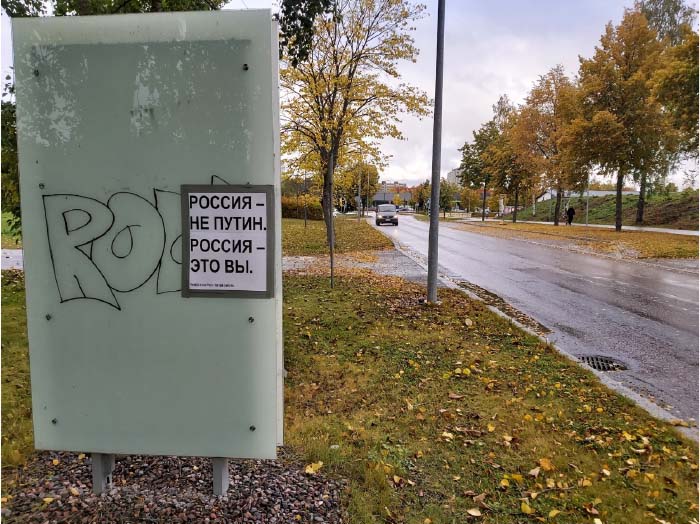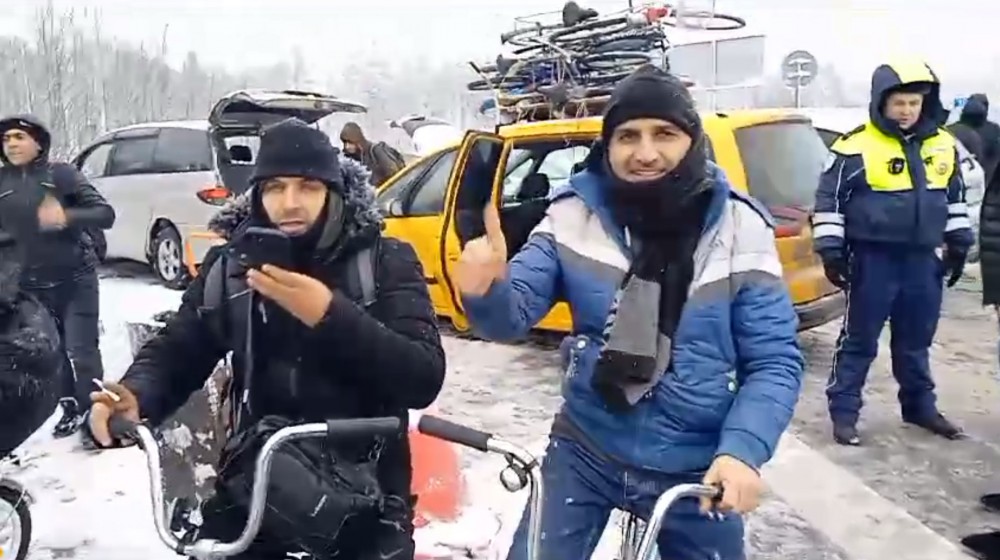World News – 2024 – Video Playlist | Video Playlists | Sites: | newsandtimes.org | links-newsandtimes.com | worldwebtimes.com | southcaucasusnews.com | russianworld.net | jossica.com | octobersurprise2016.org | bklyntimes.com | oceanavenuenews.com | fbireform.com | bloggersunite.net | octobersurprise-2024.org | Trump-News.org | Audio-Posts.com | Bklyn-NY.com | Posts Review – newsandtimes.org
Little known to those outside of Finland, Finnish Karelia is a land of lakes and deep forests and the home of a culture that founded elements of today’s Finnish identity and politics. It is also a zone contested through history: a contact line between Eastern and Western forms of Christianity, between the Swedish and Russian empires from the Middle Ages to the 19th century, and between Finnish and Soviet armies in the 20th. In the twenty-first century, Finnish Karelia has become a line of contact between a liberal, integrationist governance model and an increasingly authoritarian one in Russia.
Since Finland’s independence in 1917, Karelia has been split between it and Russia but it was once a Finnic space: the shores of the Baltic Sea and the Gulf of Finland were home to a variety of peoples speaking languages and following life patterns similar to those of the Finns, Estonians and Sami, and these extended to the White Sea, the Barents Sea, east towards the Ural Mountains and well into modern Sweden and Norway.
In the nineteenth century, its forest-bound isolation preserved a culture of poet-singers, men and women who recited from memory verses passed down for generations. These verses contained traces of an ancient Finnic mythology, layered with tales of creation, heroes and tragedy, and the arrival of Christianity. These cultural materials formed the substance of the country’s national epic poem, the Kalevala, and the work of its greatest musical composer, Jean Sibelius. The cultural movement of Karelianism shaped Finnish architecture, painting and literary imagination, lending itself to characters, metaphors and an artistic mood that persist in cultural life in the country to this day.
The establishment of St. Petersburg had a radical consequence for that Finnic space. The “wretched Finns”, as the Russian poet Aleksandr Pushkin put it in the “Bronze Horseman”, living as fishers, hunters, foresters and agrarians at the head of the River Neva, were displaced by a much more grandiose project, that of Russian Tsar Peter I, the “Great,” and his opening a “window on the West” for his empire. The decision to found an imperial capital on the Gulf of Finland reverberated across the region, portending a future of altered contact between Finnic speaking peoples and their Russian-speaking neighbours, relations that are known to have existed from the earliest medieval records.

Two corners of Karelia remain in today’s Finland, the North and South Karelias. Today, by train you emerge from the forests into North Karelia’s capital, the small city of Joensuu. It is the regional hub for many small and exotically named towns and hamlets. The town names often are based on words from Karelian, a Finnic language tinged with Russian diction, phonetics and metaphors. The spoken language there today, the modern Finnish dialect of Karelian, with its distinctive phonetics and vocabulary, is a cultural signifier in the country. In North Karelia, you see the marks of its past: a rich engagement with Russian Orthodox Christianity and a relationship to the other side of a border severed by time and repeated spats of high and violent politics.
Even today in Finland’s capital of Helsinki some few hundred kilometres southwest of Joensuu, you get the feeling that you’re on an edge, a liminal space in which a society perched itself on the first line of contact between competing systems. This mood existed profoundly during the Cold War, when Finland was not as much an edge as an interstice, weaving a distinctive geopolitics of neutrality between Soviet and American power, engendering an almost solipsistic domestic perception that Finland was in it alone when it came to survival.
On 24 February 2022, Russia’s attack on Ukraine again perched Finland on the edge, but in the very different conditions of the twenty-first century it has opted for defence integration, turning to NATO to produce greater security for itself. Living on the edge of an interstice, as Finnish Karelians have done for centuries, has had a profound effect not just on government, foreign policy and academic elites, but on the general populace.
Geopolitics is full of wagers, bets on uncertain outcomes, attempts to shift the current towards an actor’s set of preferences. Among the most famous of these wagers in recent times has been the liberal one – that exchange through a trade liberated of national barriers would foster democratic society and politics. Often our thoughts turn to the big bets, like those placed on China and Russia: the USA’s bet that trade and investment would integrate China into democracy, Germany’s staking its competitiveness on inexpensive Russian natural gas, betting economic interdependence would foster stability.
When thinking of such wagers, our thoughts rarely travel to liminal places like Karelia but that misses something about the lived experience of geopolitics, at the day-to-day level, for people who are not diplomats, intelligence agents, uniformed military or elected leaders. In places set along geopolitical fault lines, individuals experience these wagers, and keenly. It is an interesting feature of geopolitics that the experience of them is often more immediate for individuals in small societies than for those in larger societies or cities. The potential to specialize in the labour force amid more abundant economic and diverse cultural opportunity carve foreign policy, defence and national security off into esoteric activities for a sect of specialists and often secretive officials and national politicians. What is theory and strategy in Washington, London, or Ottawa is lived and felt by people in Ukraine, Taiwan, Gaza and Israel – or Karelia.
In small places on the edge, the experience of security extends from daily matters of economic security — finding a job, affordable housing, quality schooling for the next generation — to roles in the geopolitics of the day, as both subjects and objects. Subjects, in that they are more likely to fill the roles of soldier, border guard, cross-border trader. Objects, in that their “located life plans,” to use the terminology of philosopher Anna Stilz, are more likely to be undermined by events over which they have no control.
Finnish Karelians are living that experience. Russia’s aggression and its manifold consequences resonate at an individual level. In conversation in Joensuu in October, local experts conveyed to me some of the sentiments being expressed by Karelian residents. Some were asking questions like: has joining NATO made us part of the enemy camp? Were all of our efforts to cooperate with our neighbours in Russia — the front line the liberal bet — in vain? Others think, why should these grand politics affect our everyday lives? For some local inhabitants, the people of Russian Karelia seem unlikely agents of Putinist designs to rework the European map in Muscovy’s favour.

An understandable but curious thought. Finland once held much more Karelia, around Lake Ladoga. Finnic peoples had inhabited these lands since the Middle Ages. That land was shorn away by the peace settlement of World War II. Some 420,000 — basically the region’s whole Finnish citizenry and 11% of the country’s total population — were resettled in the rest of Finland. Few places have felt Russian power more acutely.
But the 1990s infused a sense that neighbouring Russia presented an opportunity. Closed lands were now open. In Helsinki and Brussels, Finland in general and the border areas in particular were seen as gateways to Russia. St. Petersburg’s proximity no longer cast a dark shadow, but emitted a bright beacon.
Academics Dr. Joni Virkkunen and Dr. Minna Piipponen, who I heard speak in Joensuu at a conference of specialists on border dynamics, have periodized Russian-Finnish Karelia cross-border evolution since January 1992, in the immediate aftermath of the Soviet Union’s dissolution mere weeks before. An era of expectation unfolded between 1992 and 1995 as the border opened, Finland sought EU membership and Russia wobbled into democracy. This then evolved into advocacy for cross-border ties from 1995 to 2000, led by the European Union and welcomed on the Russian side, and the consolidation of those ties from 2001-2013. Virkkunen and Piipponen pointed out this was not all about trade deals and diplomatic negotiations, but about people-to-people contacts being forged across the border in the forestry sector, in academia, in tourism. A perspicuous reminder of the lived experience of geopolitics.
Rumblings of trouble existed throughout the consolidation period as Russia strengthened, Virkkunen and Piipponen noted. Geopolitics in earnest intervened in 2014, when Russia annexed Ukraine’s Crimean Peninsula and started a war in eastern Ukraine’s Donbas region. From 2014 to 2021, a nervous pragmatism reigned, as local actors tried to navigate between sanctions and cooperation; the events in Ukraine were mostly “sauna talk.” That era ended in early 2022, as Russia backed up its revisionist rhetoric with revisionist action.
The sentiments of the inhabitants of North and South Karelia reflect a local expression of the disorientation and frustration geopolitics are visiting on many in Europe, North America and beyond. Finland’s Karelians now can no longer look 360º for opportunities – a microcosm of Finnish experience more broadly, but felt more acutely, more personally and more directly there, due to tight economic opportunities. They now look west and south, and increasingly north, as part of Arctic-oriented supply and value chains, for an elusive prosperity.
Echoes of previous cross-border movement — and current displacement — could be heard in Joensuu’s city square, where young Russian-speaking people gathered. PhD candidate Virpi Kaisto described how the population centres amid this “borderscape” bear the marks of the rupture, as well as the remaining effects of the COVID crisis.
Kaisto has documented and analyzed how a once thriving commerce in cross-border shopping ground to a halt, leaving parking lots empty and many Cyrillic signs taken down in the South Karelian centres of Lappeenranta and Imatra. Abundant Russian tourists, sometimes conspicuously consuming, are now conspicuously absent. In the brief time between COVID restrictions loosening and visa restrictions tightening in 2022. Russians coming to South Karelia saw Russian-language signs protesting the war and pointing to their agency in Russia’s agency: “Putin is not Russia. You are Russia,” they read. These Russians were exposed to the open debate of a liberal political culture. That window of contact closed in fall 2022.
Regionally, Russian engagement with the markets and institutions of the European Union did, at times, shape Russian participation, even if it failed to change the mentality of Russian leadership. In a case study, researcher Maria Tyshiachniouk explored the cross-border timber trade. Her work draws attention to efforts to preserve old-growth forests from the White Sea to Norway, to how Finnish and Russian civil society actors and programs of environmental certification in European markets influenced industry practices in Russian Karelia — the slow but steady and often overlooked march of the liberal bet, progress that ultimately proved to be at odds with the geopolitical instincts of the governing elite in Moscow. Now turning east to sell these products, such sustainable practices are less likely to survive, although a sort of positive inertia in the Russian industry is perpetuating them, in part because a market of Russian consumers have come to demand those standards, Tyshiachniouk discovered. Losing Finnish Karelia is certainly a loss for the political and economic development of Russia and its northwest, but the legacy of over two decades of interaction has left a strong institutional mark.

These marks are almost certainly what Russia’s political elite fears. This summer, Nikolay Patrushev, a long-time senior security figure in the Putin government, was reviving anti-Finnish tropes during a visit to the Russian Karelian capital of Petrozavodsk, tropes that had mostly lain quite since the 1930s. The Putinist narrative alleges that Finns are, with Western colleagues, fomenting separatism and unrest in Russian Karelia. These are preposterous claims: Finnish authorities long ago abandoned seeking the return of territories lost in World War II. But these allegations are all too credible, if one sees, as the Russian leadership does, the forces of democratization and integration with European and Western institutions and markets as existential threats to their power. As the Finnish diplomat and commentator Max Jakobson noted in the 1960s, it is perceptions that count in dealing with Russia, and the Russian leadership perceives a threat in Russia’s contact with European modernity.
In all likelihood, the next few years will see North and South Karelia mutate from a locally-influenced space of border negotiation to one shaped by distantly adumbrated high strategy. Dr. Pasi Tuunainen, a historian at the University of Eastern Finland and major in the military reserves, told me about some of the dynamics. He sensed that Finns, while in general supportive of the county’s NATO membership, were keen to solidify the bilateral defence relationship with the USA, the two countries are in the final stages of agreeing upon a Defence Cooperation Agreement (DCA) — and were “enthusiastic” about extra-regional UK-led initiatives like the Joint Expeditionary Force, a ten-country grouping of Nordic and Baltic countries along with the Netherlands. A lingering reluctance held, he thought, among Finns about NATO bases or housing nuclear weapons. Norwegian approaches, which had seen a lighter military presence and no NATO basing in the country’s northern-most regions, might appeal most to Finns, he thought, although a rotating NATO presence would be welcomed. It is notable, however, that in Norway these acts of geopolitical balancing are under question in the face of Russian aggression.

Some of the transformation is visible. Finland is building a fence along parts of the border, a measure officials see as dealing with Russia’s callous manipulation of migrants, directing them to an often-unwelcoming Europe Union. According to Dr. Jussi Laine, a professor at the University of Eastern Finland’s Karelia Institute, however, they are more performative, a way to offer visible signs of reassurance to Finns, rather than producing real security. In November, the number of asylum seekers arriving at Finland’s land borders with Russia spiked precipitously to over 500, an acceleration that can only be explained by the conscious work of Russian state agencies. Finland’s decision on 30 November to close the land border entirely with Russia perhaps recognizes that reality: a larger rupture with Russia has occurred, one that even the metaphor of a fence only partially captures.
Finnish Karelia is again a frontier. New wagers are being laid in distant capitals, bets that Western alliances will produce real security. NATO membership means that Finland is integrating into the world’s largest, most powerful defensive alliance. It is transforming Finnish Karelia from an interstice to an edge in the encounter between authoritarian and liberal-democratic geopolitics. It is likely to be a sharp one.
Alexander Dalziel is a senior fellow at the Macdonald-Laurier Institute in Ottawa. He has over 20 years of experience in Canada’s national security community. Previously, he held positions with the Privy Council Office, Canada School of Public Service, Department of National Defence and Canada Border Services Agency. In the 1990s, he spent an academic year at the University of Eastern Finland in Joensuu.
The post Finland’s Karelia: Living Geopolitics on an Edge appeared first on The Northern European :: UpNorth.
World News – 2024 – Video Playlist | Video Playlists | Sites: | newsandtimes.org | links-newsandtimes.com | worldwebtimes.com | southcaucasusnews.com | russianworld.net | jossica.com | octobersurprise2016.org | bklyntimes.com | oceanavenuenews.com | fbireform.com | bloggersunite.net | octobersurprise-2024.org | Trump-News.org | Audio-Posts.com | Bklyn-NY.com | Posts Review – newsandtimes.org

